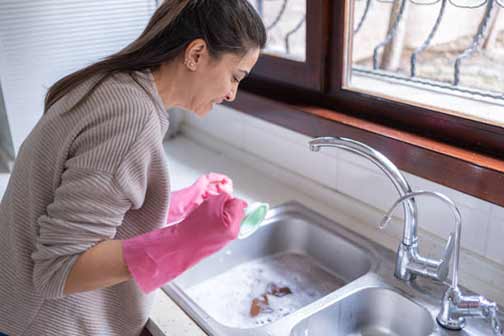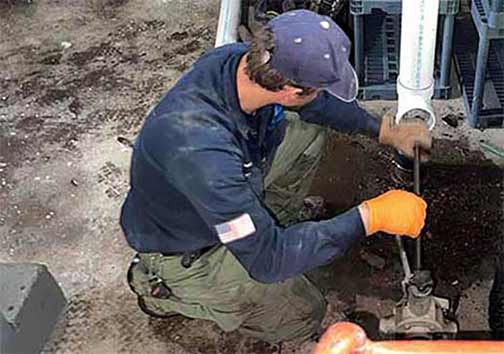
Clogged drains can make your life very difficult, warns White Robbins Management Services. Not because they are the worst plumbing problems in your home. But a clogged drain can upset you in little ways that waste your time and drain your energy, leaving you angry at the end of the day.
Think of a shower drain that clogs in the evening when you’re just getting back from work, and the only thing on your mind is a nice rinse to wash away the day’s stress. Or a kitchen sink that fills with dirty water and refuses to drain right in the middle of a Sunday meal prep.
These small events can aggregate to make your day a little less pleasant than it could be. But it doesn’t have to be that way. Clogged drains in your home happen for a reason, and there are small steps you can take to avoid or solve the problem. This post explains all of that.
Why do your drains keep clogging
Hair and soap scum buildup
We shed hair every time we go to the bathroom. Short hair lengths can bind with soap scum to form slimy residues that block the flow of water inside your pipes. To prevent this problem, install a drain screen on your shower drain and clean the screen periodically.
Grease buildup inside the pipes
Fats, oils, and grease (FOG) are a huge problem for drainage systems. Inside the cold air of your drainpipes, FOG becomes a hard, sticky substance that clings to pipe walls, traps debris, and blocks water flow. The solution is to dispose of FOG in the trash bin.
Improper disposal of food waste
Other types of kitchen waste that can clog your drains are eggshells, coffee grounds, starchy foods (rice, pasta, and mashed potatoes), and fibrous vegetables like celery. These items should not be dumped in the drains. To prevent clogs, put them in the trash bin.
Flushing the wrong items
Putting anything but human waste, toilet paper, and water into your toilet will clog it. This includes so-called flushable items, such as diapers, cotton swabs, wipes, paper towels, feminine hygiene products, and small objects. Do not use the toilet as a second trash bin.
Mineral buildup from hard water
Hard water leaves small mineral deposits in your drain lines. Over time, this buildup can become significant enough to disrupt the water flow within the pipes. The way to fix this is to have your drainpipes hydro jetted to get rid of the buildup of limescale.
Tree root invasions
Tree roots can penetrate drain lines via small leaks and cracks or weak joints. As they grow, these roots eventually block the pipe channel, causing serious drainage problems inside your home. Hydro jetting your drain lines will remove any tree roots inside the pipes.
Ground movements
Ground movements from extreme house settling, soil erosion, and flooding can undermine the soil around an underground drain line, causing the pipes to lose their support. This will lead to pipe collapse or buckling. This problem is typically solved by replacing the pipes.

Professional solutions for persistent drain clogs in your home
These are the strategies and solutions a professional plumber will deploy to tackle the problems in your drainage system.
Sewer camera inspection
A sewer camera inspection is the most advanced method to assess the physical condition of drainpipes and diagnose the problems in the system. To inspect the pipes, a specialized high-resolution waterproof camera mounted on a flexible cable is inserted into the drains through a cleanout or other access point.
A technician works the cable into the line, allowing the camera to capture a detailed video of the inside of the pipe. This recording is transmitted in real time to an above-ground screen monitored by the operator. The results are later analyzed to understand the issues in the drainage system.
Sewer rodding
Sewer rodding gives professional plumbers a way to manually remove the clogs inside your drain line. It uses a series of flexible rods that are 3 feet long individually but can be screwed together end-to-end to extend their length, making it possible to reach deep inside the drainage system.
The rods are inserted into the drain line and used to dislodge any blockages inside them. In some cases, power rodding is used. This is a steel-cutting head mounted on a flexible steel cable connected to a powerful machine. The machine spins the cutting head to shred every blockage inside the pipes.
Hydro jetting
This is currently the most effective drain cleaning method available. It uses streams of high-pressure water to blast away clogs from a drain line. A high-pressure hose with a stainless-steel nozzle is inserted into the pipe. At the other end, the hose is connected to a jetter and water tank.
The jetter pressurizes the water, sending it through the hose and allowing it to exit from the nozzle with enough force to blast away all kinds of debris from the pipes, including limescale, tree roots, sludge, and grease buildup. The best thing about hydro jetting is that it will also wash the debris out of your pipes.
Drain clogs may be a sign of bigger problems in your drainage system. Do not wait until those clogs cause a sewage backup inside your home. Have one of our experts inspect your plumbing to find the root cause of the problems in your drain lines.

